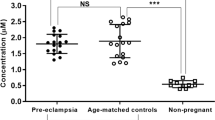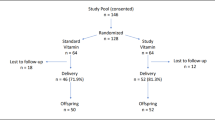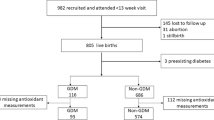Abstract
Objective: Our purpose was to investigate whether plasma lipid-soluble antioxidant levels during the third trimester of pregnancy and immediately after birth are altered in women with pregnancy-induced hypertension.
Design: Nested case-control study of women with pregnancy-induced hypertension.
Subjects: A group of 23 women with (mild) pregnancy-induced hypertension and their neonates, were compared with 23 matched controls with uncomplicated pregnancies.
Methods: Concentrations of vitamin E isomers, several carotenoids, and retinol were determined by HPLC in venous plasma which had been stored for 2–5 y. Antioxidant levels were adjusted for the degree of fatty acid unsaturation in plasma phospholipids as analysed 2–5 y before.
Results: In the third trimester of pregnancy, lipid-soluble antioxidant levels were similar in women with pregnancy-induced hypertension and controls. From the third trimester to postpartum, mean (±s.e.m.) β+γ-tocopherol levels decreased by 0.38±0.17 μmol/l or 5% (P=0.038) in the control group. In the pregnancy-induced hypertension group, however, plasma levels of most antioxidants decreased from the third trimester to postpartum, but only the decreases in plasma levels of β+γ-tocopherol of 1.08±0.27 μmol/l or 26% (P=0.042), of α-tocopherol of 2.51±1.58 μmol/l or 6% (P=0.024), and of lutein of 0.13±0.04 μmol/l or 15% (P=0.013) reached statistical significance as compared with the changes in the control group. At the same time, the polyunsaturated fatty acid unsaturation index of plasma phospholipids (UI) decreased in the pregnancy-induced hypertension group as well. Consequently, antioxidant levels, adjusted for UI, changed similarly in both groups. Umbilical vein plasma antioxidant levels were also similar after complicated and uncomplicated pregnancies.
Conclusion: Plasma lipid-soluble antioxidant levels in mother and child are affected by mild pregnancy-induced hypertension, but this effect disappears after adjustment for fatty acid unsaturation.
This is a preview of subscription content, access via your institution
Access options
Subscribe to this journal
Receive 12 print issues and online access
$259.00 per year
only $21.58 per issue
Buy this article
- Purchase on Springer Link
- Instant access to full article PDF
Prices may be subject to local taxes which are calculated during checkout
Similar content being viewed by others

Author information
Authors and Affiliations
Rights and permissions
About this article
Cite this article
Oostenbrug, G., Mensink, R., van Houwelingen, A. et al. Pregnancy-induced hypertension: maternal and neonatal plasma lipid-soluble antioxidant levels and its relationship with fatty acid unsaturation. Eur J Clin Nutr 52, 754–759 (1998). https://doi.org/10.1038/sj.ejcn.1600642
Received:
Revised:
Accepted:
Published:
Issue Date:
DOI: https://doi.org/10.1038/sj.ejcn.1600642


